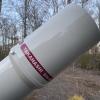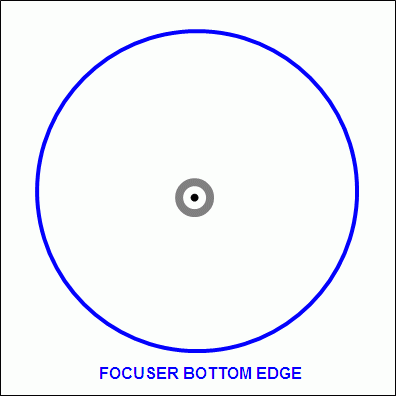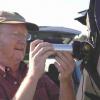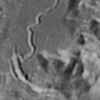
Which to trust Hotech laser or collimation cap
#1

Posted 18 January 2014 - 12:55 PM
Thanks
Alonzo
#2

Posted 18 January 2014 - 01:27 PM
...I can get my scope collimated with collimation cap with black dot from peephole centered in my primarys doughnut and all circles concentric but when I confirm with a hotech laser the collimation is of. I can collimate with the laser but I don't know which to believe. My sight tube also backs up my collimation with the collimation cap.
Thanks
Alonzo
Alonzo:
I am guessing you are not using Nils "Barlowed Laser Collimation Technique" but rather relying on the return beam of the laser... if so, I would trust the collimation cap.
If you have a Barlow, try the Barlowed Laser, it should agree with the other two.
(I would provide a link but I am on my cell phone.)
Jon
#4

Posted 18 January 2014 - 02:31 PM
...I can get my scope collimated with collimation cap with black dot from peephole centered in my primarys doughnut and all circles concentric but when I confirm with a hotech laser the collimation is of. I can collimate with the laser but I don't know which to believe. My sight tube also backs up my collimation with the collimation cap.
Thanks
Alonzo
Collimation consists of 3 alignments:
1- Centering/rounding the secondary mirror under the focuser
2- Aligning the focuser axis
3- Aligning the optical axis
Quality single beam laser collimators do a good job for #2 and #3 but they can't be used for #1
Quality collimation caps do an OK job for #1/#2 and a good job for #3
Refer to the following post to get the most out of both tools:
http://www.cloudynig...eflectors/Nu...
Jason
#5

Posted 18 January 2014 - 07:56 PM
Thanks
Alonzo
#6

Posted 18 January 2014 - 08:18 PM
the answer is the cap but try the laser with the barlow and see if there is a difference. Also I have ready you need to check the alignment of the laser. It can be off.
Paul
#7

Posted 18 January 2014 - 09:46 PM
Thanks
Alonzo
#8

Posted 19 January 2014 - 12:01 AM
....I still need a definite answer do I trust the collimation cap or the Hotech laser.
Thanks
Alonzo
This is not a fair question. All quality collimation tools should agree. Because each tool has its strength and weakness, you need to re-iteration between tools until all agree.
Jason
#9

Posted 19 January 2014 - 12:15 AM
#10

Posted 19 January 2014 - 03:09 AM
Because the center of the mirror is hidden, there could be errors in the center of the primary that will throw off a laser. These may not be corrected by the optician because the rest of the surface is quit good. For this reason I would only use the laser for rough alignment.
Typically, the reason is much simpler. Collimation caps do a poor job in focuser axial alignment. Laser collimators do a better job. The is the main source of discrepancy.
Check the attached animation. It is tough to center the primary mirror center spot reflection within the view via the collimation cap pupil.
Jason
#11

Posted 19 January 2014 - 04:41 AM
Terry
#12

Posted 19 January 2014 - 05:23 AM
If the beam misses the exact center of the marker (but still within its center hole - this is in itself of little or no consequence), and then the return beam is aligned, there will be a possibly significant miscollimation of the primary.
Also, as the return beam vanishes in the aperture, its position may not be easily read. The cross lines in a Hotech collimator may help, I haven't tried and don't know.
Collimation caps, it is rumored, may have its peephole poorly centered - worth checking. Also, it might be worth the trouble checking the centering of the marker on the primary.
Because the center of the mirror is hidden, there could be errors in the center of the primary that will throw off a laser. These may not be corrected by the optician because the rest of the surface is quit good.
Considering how mirrors are figured and tested: thwe center may be a bit high or low, but it will be quite perpendicular to the optical axis, and this is not a reasonable problem cause.
#13

Posted 19 January 2014 - 06:00 AM
I would trust a star.
#14

Posted 19 January 2014 - 07:26 AM
This is not a fair question. All quality collimation tools should agree. Because each tool has its strength and weakness, you need to re-iteration between tools until all agree.u
Jason
Jason:
I was using my first Howie Glatter laser collimstor before Nils Olof Carlin's stroke of genius: the Barlowed Laser.
This is how I see it.
Honestly, I find it impossible to say that that the single beam laser can be depended upon to align the primary mirror. In theory it is possible if there are no other alignment errors and no registration errors. However, the reality is that the return beam is sensitive to not only the alignment of the primary mirror but also a number of other factors. For example, the secondary alignment can be within tolerance but this is not sufficient for return beam alignment. The sensitively of the return beam to other factors can be seen by loosen the set screw and rocking the collimator, the return beam can be seen to move about wildly.
The beauty of the Barlowed Laser is that it is insensitive to registration errors and other small, otherwise unimportant alignment errors and essestially only sensitive to the primary tilt. The same test of loosening the focuser set screw can be perform but with the Barlowed laser, the return shadow remains fixed while the laser is moved about.
Historically, the Barlowed laser was what made laser collimation truly possible..
That's how it looked to me at the time and it still looks that way.
Jon Isaacs
#15

Posted 19 January 2014 - 08:44 AM
#16

Posted 19 January 2014 - 09:22 AM
#17

Posted 19 January 2014 - 10:29 AM
Thanks
Alonzo
#18

Posted 19 January 2014 - 10:36 AM
Jason:
Jon, I was using my first Howie Glatter laser collimstor before Nils Olof Carlin's stroke of genius: the Barlowed Laser.
Refer to the OP's first post. Based on the problem's description, the problem seems to be due to a gross focuser axial alignment. The way I see it, this thread is not about optical axial alignment but rather the thread is about a gross focuser axial alignment. One of the main points I made in this thread is that collimation caps do a poor job for focuser axial alignment, hence, the typical cause of discrepancy against quality laser collimators.
In my posts I kept referring to "quality" collimation caps and "quality" laser collimators. Any collimation tool with questionable quality could be useless regardless of the tool's type.
Jason
#19

Posted 19 January 2014 - 02:10 PM
In my posts I kept referring to "quality" collimation caps and "quality" laser collimators. Any collimation tool with questionable quality could be useless regardless of the tool's type.
Jason:
My concern is/was that you wrote that a quality laser collimator was a good tool for aligning the primary mirror. My experience is that without some form of the Barlowed laser, even the best laser collimator is not sufficient.
As far as the actual difficulty in this particular case, I trust your judgment...
Jon
#20

Posted 19 January 2014 - 03:26 PM
I would trust a star.
A star test may show the collimation of the primary, but if the problem (the OP is quite vague) is miscollimation of the focuser axis, the star image won't give you any help at all.
Nils Olof
#21

Posted 19 January 2014 - 08:34 PM
David
#22

Posted 19 January 2014 - 10:17 PM
How far off is the Hotech laser?...I can get my scope collimated with collimation cap with black dot from peephole centered in my primarys doughnut and all circles concentric but when I confirm with a hotech laser the collimation is of. I can collimate with the laser but I don't know which to believe. My sight tube also backs up my collimation with the collimation cap.
Generally speaking, the outgoing laser beam is used to align the focuser axis (laser dot aligned to primary mirror center spot/donut).
The return beam can be used for coarse alignment of the primary mirror, but you should be able to get a more precise read of the primary mirror alignment with your collimation cap or Cheshire (aligning the collimation cap pupil or the bright Cheshire ring to the primary mirror center spot/donut).
All of these alignments are easily verified by rotating the various alignment tools in the focuser.
#23

Posted 19 January 2014 - 11:07 PM
Thanks
Alonzo
#24

Posted 20 January 2014 - 09:05 AM
Just to clarify, what I was concerned about when I asked, "How far off is the Hotech laser?", is, the answer, with regard to your observation, "...when I confirm with a hotech laser the collimation is of(f)." I wanted to know "how far off" the difference was between the "all circles concentric" alignment and the laser alignment....Vic I checked the Hotech laser and it is dead true.
#25

Posted 20 January 2014 - 06:06 PM
Once the focuser is collimated/squared and the secondary mirror is properly positioned, rotated and adjusted beneath the focuser, THEN I use a Hotech crosshair laser collimator to adjust the primary mirror. Finally I follow-up with a star test.
My standard Newt collimation kit consists of a 1.25" Cheshire tube, two 2" extension tubes, Hotech SCA crosshair collimator, thread-on 1.25" barlow and a Lasermax TLC holographic adapter.
So in answer to the OP's original question about "which is best", I would say that NEITHER is intended as your only collimation tool.




























